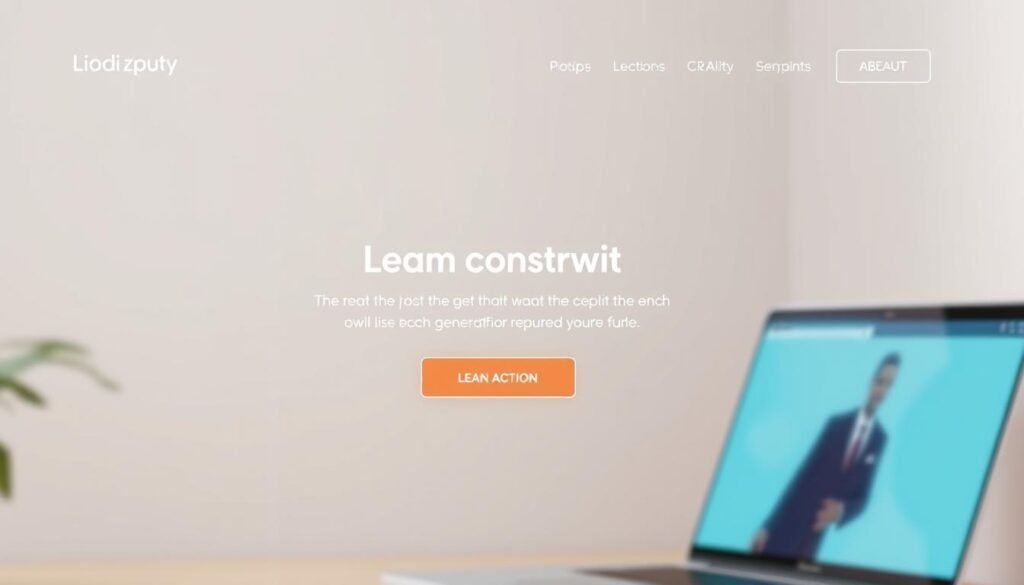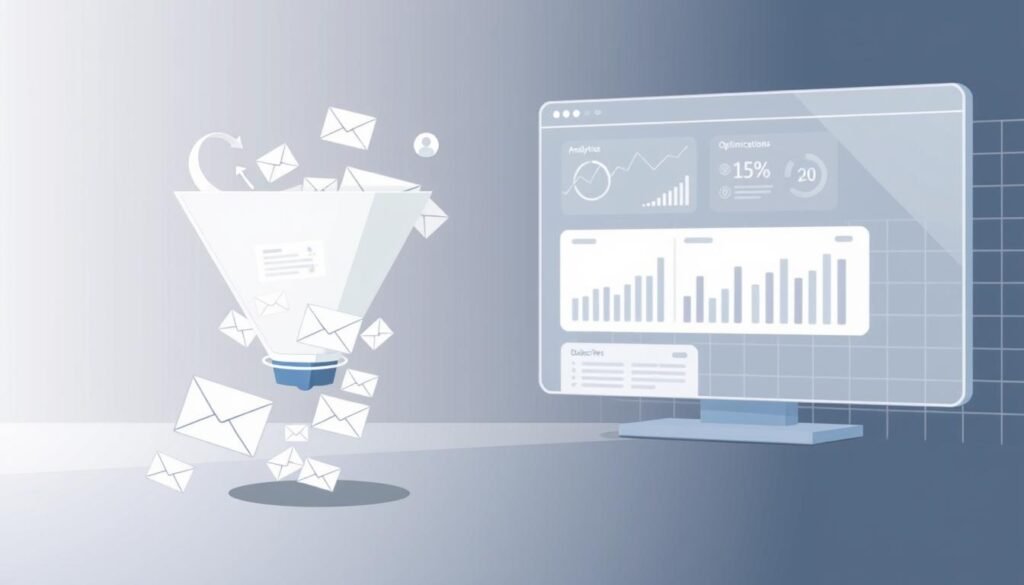How can a durable email asset outperform fleeting social reach?
You control an email list in ways social media and search never allow. An owned audience resists algorithm shifts and converts warmer. Warm subscribers act more like customers than passive followers.
This introduction shows how to align a newsletter, a landing page, and your website to a clear target audience. You will learn practical steps to capture people, collect accurate information, and prompt action with simple pages and forms.
Quality beats quantity. Keep addresses verified, enable easy unsubscribes, and segment so opens and clicks rise while bounces fall. We also preview how one platform can help you automate capture, nurture, and analysis. For a closer look at platform fit, see this product review.
Key Takeaways
- Owned email assets resist algorithm changes and drive higher conversion.
- Align landing and website pages to a defined target audience.
- Prioritize list hygiene: verify, segment, and allow unsubscribes.
- Design pages that make value clear and prompt the next action.
- Use an optimization loop: capture, nurture, qualify, analyze.
Why list building matters now: benefits, benchmarks, and business impact
Owned email audiences give you control and predictable ROI that social channels cannot match. You can target messages, measure results, and scale campaigns without relying on search engine or social media algorithms.
Practical benchmarks help set expectations. Embedded signup forms average about 0.5–2% opt-in. Popups usually convert between 1–10%. A dedicated landing page across industries hit 7.12% in 2024.
These rates translate directly to conversions and sales. With a verified email list you send personalized emails to potential customers and track engagement. That drives higher conversion vs broad social audiences.
Quality practices protect value. Verify addresses, segment by interest, and routinely remove inactive contacts. Make unsubscribes easy to keep deliverability high and bounces low.
- Estimate leads using capture rates and landing page CVR to forecast business impact.
- Use permission-based information policies to build trust and reduce compliance risk.
- Treat your newsletter as a channel that converts website visitors into repeat customers.
Lay the groundwork: turn your newsletter into a product your audience values
Turn each email into a purposeful touchpoint that answers a real customer question. Treat your newsletter like a product: define a clear value proposition and map issues your target audience faces. That alignment makes your content something people choose to receive and read.
Define value
Map topics to customers’ pain points and information needs. Use reply-enabled emails, quick surveys, and webinar Q&A to learn what people want. Two-way feedback keeps content relevant and helps your brand earn attention over time.
Quality over quantity
Segment early by demographics and interests to keep messages relevant. Verify addresses and run a hygiene cadence that removes stale contacts and improves engagement.
Compliance essentials
Confirm consent with double opt-in and document privacy practices. Make unsubscribe options clear and respectful to lower complaints and strengthen trust.
- Productize your newsletter with a specific value promise tied to customer outcomes.
- Design feedback loops (replies, surveys, events) to capture information about content demand.
- Implement segmentation and regular cleaning to protect deliverability and engagement.
- Use double opt-in and visible unsubscribe paths to reinforce permission-based growth.
Capture more contacts on your website with GetResponse forms and popups
Place concise signup forms across your site and combine them with targeted popups to lift conversion without annoying people.
Start with a global newsletter form visible on every page, then add a timed popup after about 10 seconds of engagement. Embedded forms in footers and sidebars typically convert 0.5–2%. Popups can reach 1–10% when used as a complement, not a replacement.
Where and how to use signup forms and popups
Map form placements across your website: footer, sidebar, account/cart areas, and high-traffic pages. Keep each signup form short—name and email—and link to a dedicated landing page when needed.
Boost intent with double opt-in and smart display rules
Use double opt-in to confirm consent, reduce fake emails, and protect deliverability. Pair that with smart display rules like time-on-page, scroll depth, and exit intent to surface offers at the right moment.
- Use templates and many display rules to test visuals and triggers quickly.
- Mix popup types—welcome mats, exit-intent, fixed bars—sparingly to avoid fatigue.
- Track conversion rates to forecast volume and prioritize tests that move the needle.
Test copy, creative, and timing with small experiments. Measure email capture, conversion, and downstream campaign results to refine how your audience finds value and acts.
Build and optimize high-converting landing pages and lead magnets

A high-converting landing page starts with one clear promise and a fast, mobile-first experience. Design with a single goal: get an email and deliver the promised resource instantly.
Step-by-step:
Step-by-step: create branded, mobile-first landing pages
Choose a predesigned template, tailor brand colors and logo, and write benefit-led copy that answers the visitor’s question. Add a concise signup form, enable double opt-in, and complete subscription settings before publishing the page URL.
Make the mobile version first. Use drag-and-drop tools and AI content features to speed production. Connect the page to an autoresponder so every signup triggers immediate delivery and next steps.
Lead magnet ideas that convert
Offer practical resources tied to the audience’s top questions: ebooks, checklists, guides, reports, mini-courses, resource kits, or frameworks. Pick one that maps to a high-intent problem and promise quick, actionable value.
Set targets with data
Use the 2024 average landing page CVR of 7.12% as a benchmark. Prioritize tests on headline, hero offer, social proof, form length, and page layout to lift conversion.
| Element to Test | Why It Matters | Expected Impact |
|---|---|---|
| Headline | First impression and clarity of benefit | +10–30% conversion uplift |
| Form length | Friction vs. qualification | Shorter forms often increase conversions |
| Social proof | Builds trust and reduces hesitation | Better trust can lift signups by 5–15% |
| Mobile load time | Speed affects bounce and completion | Faster pages improve conversion and SEO |
Drive targeted traffic: social media, Facebook/Instagram ads, and Google Ads
Use paid social and search to push high-intent audiences to tightly matched pages. Start small: choose a clear offer, set a modest budget, and measure which creative and keywords bring potential customers.
Launch Facebook/Instagram ads from the platform
You can create Facebook and Instagram ads in five steps: name the campaign, connect your business page, select a target audience, set budget and run time, then craft the ad content. Keep the destination simple: one landing page that mirrors the ad promise.
Capture high-intent demand with Google Search Ads
Google Search campaigns follow a similar five-step flow: name, link or create an account, add headlines and descriptions, choose audience, set budget and schedule. Preview ads on desktop and mobile to check headlines and final URLs.
Social tactics that work
Optimize organic with profile bio links to your lead magnet and use content hooks in posts that point to that profile link. By driving traffic to your lead magnet, you can effectively turn your audience into engaged prospects. Implementing getresponse lead nurturing workflows will help you automate follow-ups, ensuring that your leads receive timely and relevant information that guides them through the decision-making process. This strategy not only enhances conversion rates but also builds stronger relationships with your audience over time.
- Test giveaway promos and mobile-first lead ads to lower friction and generate rapid email captures.
- Start with broad audiences, then refine using early search queries and ad performance data.
- Use consistent UTM tagging so you can attribute conversions across social media and search engine campaigns.
Quick win:send paid traffic to the strongest landing offer and measure conversions by channel. This lets you scale budgets toward the audiences and creatives that actually convert customers.
Expand reach fast with webinars, partnerships, and referrals
Webinars, partnerships, and referral programs accelerate audience growth without heavy ad spend. Use live events to teach, capture permissioned emails, and move attendees into nurture flows. A single webinar can produce qualified contacts and content you reuse over time.
Plan webinars that generate and nurture leads inside GetResponse
Set a title, URL, date, duration, and a thank-you page. Configure registration and subscription details and schedule automatic reminders. This workflow sends attendees to a clear next step after the event.
Promote the event with a dedicated landing page, targeted email campaigns, and social media posts. Record the session and turn the recording into an evergreen resource to drive continuous signups to your email list.
Co-marketing and newsletter referrals: tapping shared audiences
Find partner brands with overlapping audiences and co-create assets—webinars, ebooks, or joint emails. Document roles, promo calendars, and tracking so attribution stays clear and both brands benefit.
- Referral programs: Reward subscribers for inviting peers using tools like GrowSurf, ViralSweep, or Gleam.
- Co-created content: Partner assets reduce cost and expand reach without extra ad spend.
- Reuse recordings: Convert webinars into landing page magnets and automated campaigns to maximize time and ROI.
getresponse list building strategies for lead generation in action: automate nurture and qualify
A disciplined welcome flow converts curiosity into action by setting expectations and delivering fast wins.
Build a welcome series: educate, engage, and incentivize first action
Start with a high-performing welcome email that confirms subscription and delivers value immediately. That first message often drives very high open and click rates.
Follow with two educational emails that teach customers how your services solve a clear problem. End the series with a timed incentive to prompt an initial action on your landing page or website.
Automation and tags: personalize journeys based on behaviors
Use automation workflows with conditions, actions, and filters so each person gets relevant emails. Tag contacts when they open, click, purchase, or visit key pages.
Tags unlock personalization: tailor subject lines, offers, and follow-ups based on behavior to raise engagement and conversions.
Engagement scoring: segment hot leads for timely follow-ups
Apply an Engagement Score with five levels: Not engaged, At-risk, Neutral, Engaged, and Highly engaged. Use Engaged and Highly engaged as hot segments for sales outreach.
Create re-engagement plays for at-risk people and connect automation to a clean contact list structure so scaling stays organized and compliant.
- Design a three-stage welcome flow: deliver value fast, educate clearly, then offer a timed incentive.
- Tag key events to enable granular personalization and smarter timing.
- Use engagement scoring to prioritize follow-ups and optimize marketing campaigns.
- Add simple reports to spot where an extra touchpoint or stronger CTA will improve results.
Measure, optimize, and scale your lead generation with funnels and analytics

Measure each step of your funnel so you can see which pages and emails actually move potential customers. Conversion Funnels standardize signup pages, download pages, and autoresponders so you compare apples to apples.
Use Conversion Funnels and integrated reporting to track results
Set up funnels that connect a landing page, a signup page, and the autoresponder that follows. Integrated reporting then shows drop-off rates, conversion, and revenue by channel.
Tools help you track traffic from social media and search engine ads to see which campaign brings the highest-quality potential customers.
A/B testing, mobile readiness, and local targeting to lift conversions
Run disciplined A/B tests on headlines, subject lines, and form length to lift conversion without extra ad spend. Keep tests small and iterate on winners.
Make sure every page is mobile-ready and fast. Mobile improvements often yield immediate gains in conversions from visitors on the go.
Layer local targeting with geo-focused pages and ads. Use local reviews on landing pages to boost trust and validate results in your analytics.
- Standardize naming conventions and dashboards so your team reads data the same way.
- Track cross-channel performance to reallocate budget toward the best-performing campaigns.
- Use funnel reports to prioritize tests that increase engagement and sales.
Conclusion
Close the loop: make your website, signup form, and follow-up emails work as one system.
Build a clear, repeatable plan: craft valuable content, publish a focused landing page, and connect that page to a welcome email sequence.
Drive traffic from social, search, and partners so visitors find the right page. Then let automation deliver value and nudge people toward your products or sales offers.
Measure, test, and name each asset consistently. Make sure your reporting shows which signup form and landing assets move the needle.
Document wins, tidy your email list, and iterate. Do this and your email marketing becomes a durable way to generate leads and grow customers.

